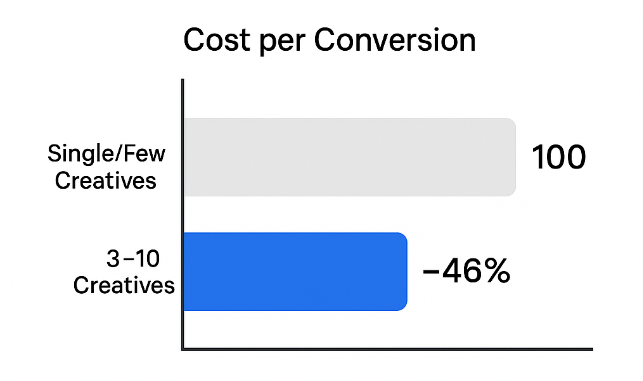A creative testing matrix is one of the most reliable frameworks for finding high-performing ads without overspending. Instead of testing random ideas, the matrix organizes creative elements into structured variations, helping teams quickly understand what truly moves performance metrics.
According to Meta’s internal data, advertisers who systematically test creative variations see up to a 30% reduction in cost per result as platforms learn faster from diversified inputs. With competition rising in every industry, structured creative testing is no longer optional—it’s a performance advantage.
Why a Creative Testing Matrix Works
A matrix allows you to break creative into components and test them methodically. By isolating variables, you avoid wasting budget on intuition-based tests and instead rely on data-driven decisions.
A complete matrix typically includes:
-
Concepts (angles, hooks, themes)
-
Formats (image, video, carousel, vertical video)
-
Visual elements (colors, layouts, product focus)
-
Copy variations (hooks, CTAs, body text length)
Testing these elements systematically allows you to uncover what resonates faster and identify patterns across campaigns.
Step-by-Step: How to Build a Creative Testing Matrix
1. Start with 3–5 Concepts
Concepts—also called angles or value propositions—are the backbone of your matrix. Identify 3–5 clear concepts that reflect your product’s benefits or customer pain points.
Example concepts:
-
Ease and simplicity
-
Cost reduction
-
Fast results
-
Social proof
-
Innovation or uniqueness
2. Layer Formats and Structures
Each concept should be expressed across multiple formats. Meta reports that vertical, mobile-first creatives can drive up to 12% higher conversion rates compared to non-optimized formats.

Vertical, mobile-optimized video ads achieved a 12% higher conversion rate compared with standard video formats
Common formats to include:
-
Static image
-
Short video
-
Vertical video
-
Carousel
3. Test Visual Variables
Even small creative differences can dramatically shift campaign outcomes. Studies show that color contrast alone can influence click-through rates by up to 30%.
Include visual tests such as:
-
High vs. low color contrast
-
Product-only vs. lifestyle visuals
-
Light vs. dark backgrounds
4. Add Copy Variations
Your matrix should include different hooks, body lengths, and CTAs.
Test multiple:
-
Opening hooks
-
Benefit-driven vs. feature-driven text
-
Short vs. medium copy
-
CTA phrases
5. Prioritize Based on Early Signals
Once your variations start running, evaluate early performance from the first 1,500–2,000 impressions per creative. Metrics like thumb-stop rate, CTR, and hold rate indicate whether a creative deserves more spend.
Winners scale quickly, while underperformers are paused to protect budget.
How to Run Smart Creative Experiments
Use a Control Creative
Always compare new variations against a strong baseline. A reliable control ensures every test shows real performance differences.
Test Concepts Before Details
The most valuable insights come from testing top-level creative angles first. Once you find a winning angle, refine the visuals and copy within that theme.
Avoid Testing Too Many Variables At Once

Ad sets using 3–10 different creatives saw a 46% lower cost per conversion compared with ad sets with fewer creatives
Oversized test groups dilute learning and increase cost. Limit each test to 4–6 variations.
Example of a Simple Creative Testing Matrix
| Concept | Format | Visual Test | Copy Test |
|---|---|---|---|
| Ease & Simplicity | Vertical Video | Light vs. dark | Short vs. long |
| Fast Results | Static Image | High vs. low contrast | Hook A vs. Hook B |
| Social Proof | Carousel | Product vs. lifestyle | CTA test |
A lightweight matrix like this helps teams generate insights quickly and scale what works.
When to Scale Your Winning Creatives
Scale when creatives consistently show:
-
CTR above your account’s median
-
Stable cost per result beyond 2–3 days
-
At least 20–30% stronger results than the control creative
Scaling winners early helps reduce learning-phase time and lowers overall acquisition costs.
Final Thoughts
A creative testing matrix turns creativity into a predictable, repeatable system. Instead of guessing what will perform, you generate insights fast and reinvest only in what truly matters. The result: faster wins, smarter scaling, and more efficient paid campaigns.

